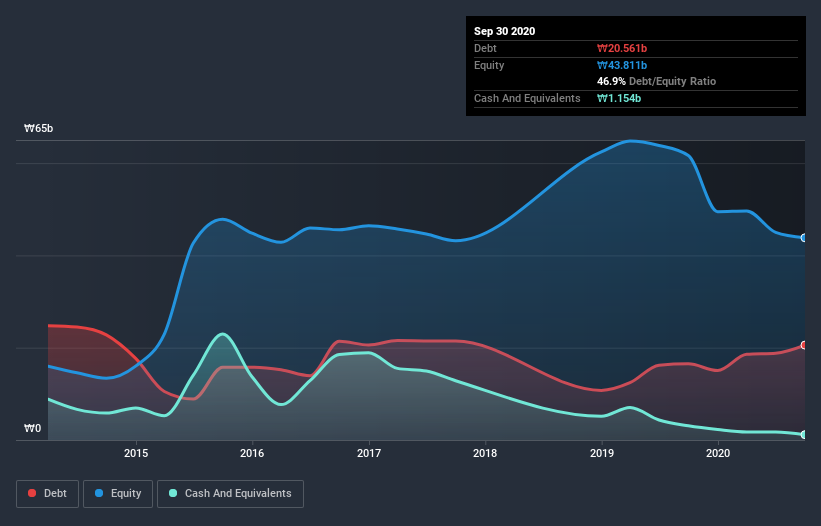- South Korea
- /
- Specialty Stores
- /
- KOSDAQ:A069920
Here's Why ISE Commerce (KOSDAQ:069920) Can Afford Some Debt
David Iben put it well when he said, 'Volatility is not a risk we care about. What we care about is avoiding the permanent loss of capital.' So it might be obvious that you need to consider debt, when you think about how risky any given stock is, because too much debt can sink a company. As with many other companies ISE Commerce Company Limited (KOSDAQ:069920) makes use of debt. But the more important question is: how much risk is that debt creating?
When Is Debt A Problem?
Debt and other liabilities become risky for a business when it cannot easily fulfill those obligations, either with free cash flow or by raising capital at an attractive price. In the worst case scenario, a company can go bankrupt if it cannot pay its creditors. However, a more common (but still painful) scenario is that it has to raise new equity capital at a low price, thus permanently diluting shareholders. Having said that, the most common situation is where a company manages its debt reasonably well - and to its own advantage. The first step when considering a company's debt levels is to consider its cash and debt together.
View our latest analysis for ISE Commerce
What Is ISE Commerce's Net Debt?
You can click the graphic below for the historical numbers, but it shows that as of September 2020 ISE Commerce had ₩20.6b of debt, an increase on ₩16.5b, over one year. However, because it has a cash reserve of ₩1.15b, its net debt is less, at about ₩19.4b.

How Healthy Is ISE Commerce's Balance Sheet?
Zooming in on the latest balance sheet data, we can see that ISE Commerce had liabilities of ₩32.3b due within 12 months and liabilities of ₩438.7m due beyond that. Offsetting this, it had ₩1.15b in cash and ₩21.0b in receivables that were due within 12 months. So its liabilities outweigh the sum of its cash and (near-term) receivables by ₩10.5b.
Of course, ISE Commerce has a market capitalization of ₩90.3b, so these liabilities are probably manageable. But there are sufficient liabilities that we would certainly recommend shareholders continue to monitor the balance sheet, going forward. There's no doubt that we learn most about debt from the balance sheet. But you can't view debt in total isolation; since ISE Commerce will need earnings to service that debt. So if you're keen to discover more about its earnings, it might be worth checking out this graph of its long term earnings trend.
In the last year ISE Commerce wasn't profitable at an EBIT level, but managed to grow its revenue by 17%, to ₩40b. That rate of growth is a bit slow for our taste, but it takes all types to make a world.
Caveat Emptor
Importantly, ISE Commerce had an earnings before interest and tax (EBIT) loss over the last year. Indeed, it lost ₩5.4b at the EBIT level. Considering that alongside the liabilities mentioned above does not give us much confidence that company should be using so much debt. So we think its balance sheet is a little strained, though not beyond repair. Another cause for caution is that is bled ₩9.3b in negative free cash flow over the last twelve months. So suffice it to say we consider the stock very risky. When analysing debt levels, the balance sheet is the obvious place to start. However, not all investment risk resides within the balance sheet - far from it. Take risks, for example - ISE Commerce has 3 warning signs (and 2 which are a bit concerning) we think you should know about.
At the end of the day, it's often better to focus on companies that are free from net debt. You can access our special list of such companies (all with a track record of profit growth). It's free.
If you decide to trade ISE Commerce, use the lowest-cost* platform that is rated #1 Overall by Barron’s, Interactive Brokers. Trade stocks, options, futures, forex, bonds and funds on 135 markets, all from a single integrated account. Promoted
Valuation is complex, but we're here to simplify it.
Discover if Exion Group might be undervalued or overvalued with our detailed analysis, featuring fair value estimates, potential risks, dividends, insider trades, and its financial condition.
Access Free AnalysisThis article by Simply Wall St is general in nature. It does not constitute a recommendation to buy or sell any stock, and does not take account of your objectives, or your financial situation. We aim to bring you long-term focused analysis driven by fundamental data. Note that our analysis may not factor in the latest price-sensitive company announcements or qualitative material. Simply Wall St has no position in any stocks mentioned.
*Interactive Brokers Rated Lowest Cost Broker by StockBrokers.com Annual Online Review 2020
Have feedback on this article? Concerned about the content? Get in touch with us directly. Alternatively, email editorial-team (at) simplywallst.com.
About KOSDAQ:A069920
Exion Group
Operates in the fashion business in South Korea, China, the United States, Japan, and internationally.
Excellent balance sheet with moderate risk.
Market Insights
Community Narratives




